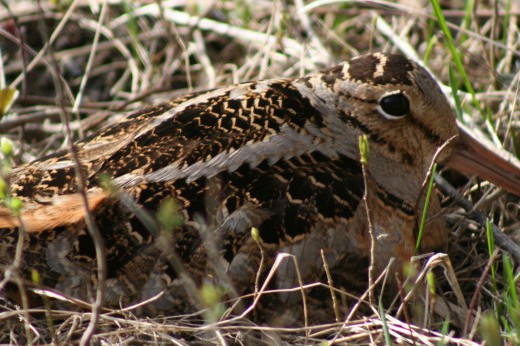I had a rare and wonderful experience as I was walking through the Garden at dusk one night last week, just about 6 p.m. I was strolling through Cherry Esplanade when I thought I heard the “peent” call of an American woodcock coming from the Cranford Rose Garden. Suspecting this to be the product of an overactive imagination induced by my late-winter lust for spring, I nevertheless walked hopefully toward the sound to investigate. As I stood outside the white lattice fence surrounding the Rose Garden, I could clearly hear the loud, buzzy peents repeated at regular intervals of about three to five seconds. Just a minute or so later, I heard the bird burst into flight and immediately saw his unmistakable silhouette as he popped up over the white fence right above my head. Tubby round body, big head, no neck, and an outlandishly long bill…the woodcock sighting was confirmed! I stood in the gathering darkness, listening to the live soundtrack of this amazing bird as he conducted his flight display, finally landing back in the Rose Garden to begin his peent chorus all over again. The first bird sign of spring has arrived in Brooklyn!
The American woodcock is the leading contender for oddest bird in North America. Though it is considered a shorebird, its inelegant proportions are adapted to life in upland habitats well away from the coast. Its short legs keep it close to the ground, and a long bill with a flexible tip is the perfect tool for probing into the mud for its favorite food, earthworms. The woodcock’s large eyes, set far back on the head, allow this bird to watch over its shoulder for danger while feeding, and its mottled brown feathers make it nearly impossible to see among dead leaves on the ground. Given the bird’s habit of hiding under shrubs in a dense thicket and freezing in place when danger is near, it might well have remained an undiscovered species but for its elaborate courtship display.
Each year in the very early spring, male woodcocks perform a song-and-dance routine in an open field at dusk, aiming to attract a lonely female. Its loud peent call is accompanied by a bobbing dance on the ground. Next comes the sky-dance flight, tracing a distinct pattern high up into the air and spiraling slowly back to earth. The woodcock’s wing feathers produce a sharp chirping sound as they beat through the air, so even if the bird is out of view, his entire dance sequence can be followed by the sounds alone.
If you’re thinking this bird sounds too exotic to be found in a central Brooklyn neighborhood, you’re only partly right. I don’t expect any male woodcocks will turn the Rose Garden lawn into their favorite dancing ground for the next several months. However, the early-spring migration of woodcocks to nesting grounds in the surrounding region and farther north brings a high number of the birds through Brooklyn, and some may just settle down in the Garden for a few nights’ rest. After my encounter, I checked online with eBird, a citizen science project from the Cornell Lab of Ornithology and the Audubon Society, and discovered many birders had reported seeing woodcock at locations all across the city last week, so the migration is on for 2013!
If you’re curious, check out the description of the woodcock courtship ritual here.
And Cornell gives a good photo and audio clip.



